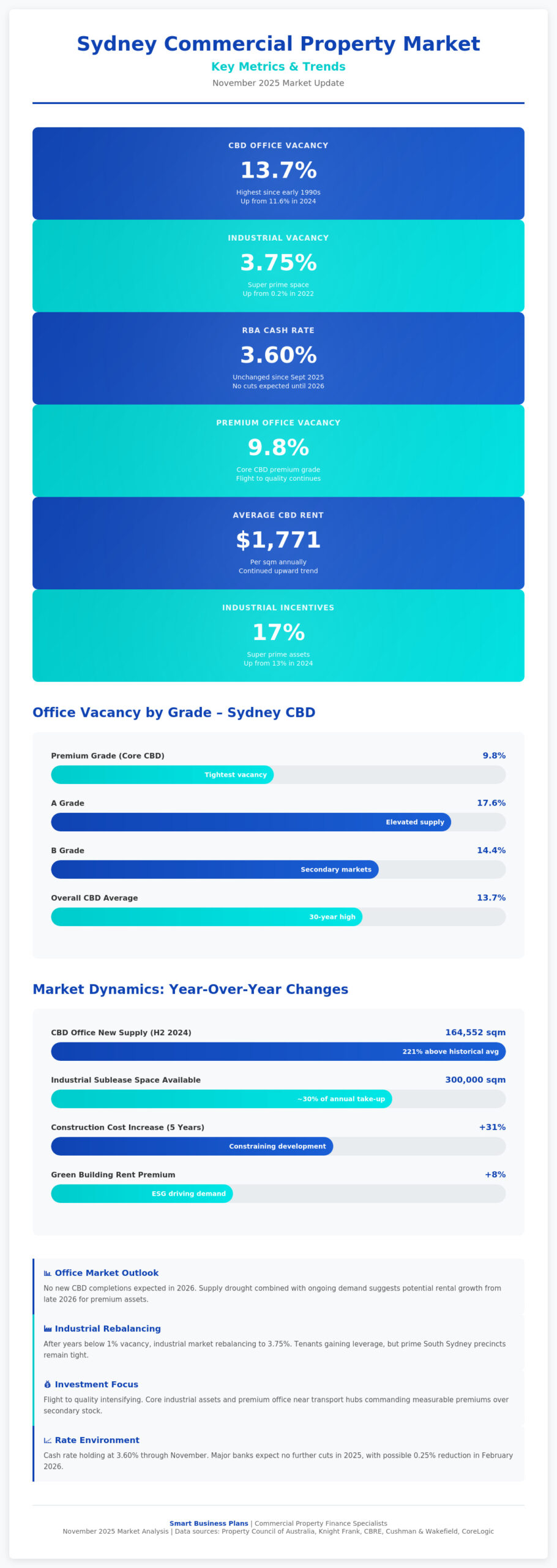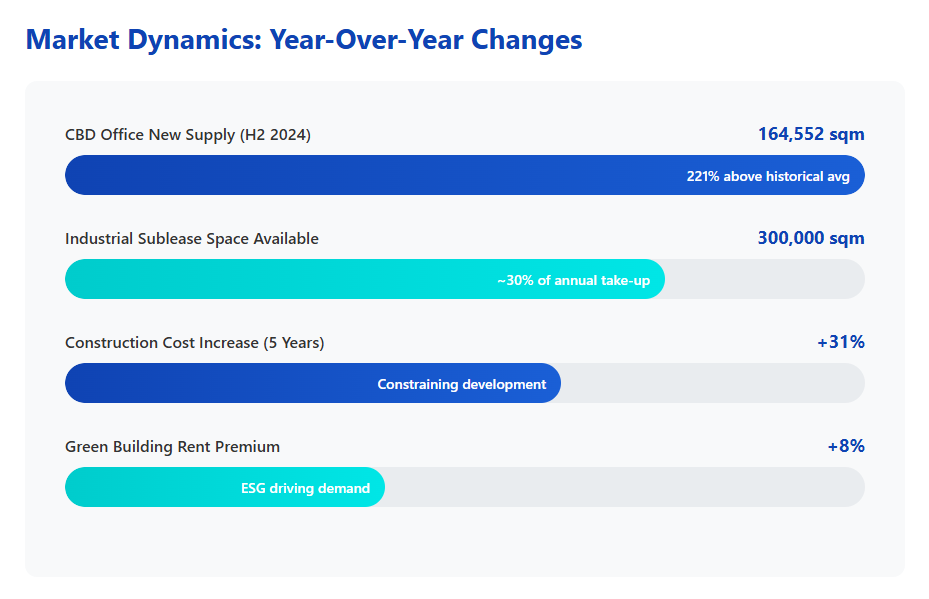As we head toward the end of 2025, I’ve been closely monitoring how the Sydney commercial property market is evolving, and November brings some significant developments worth discussing. The market is experiencing divergent trends across sectors; office vacancies are reaching multi-decade highs while industrial remains comparatively tight, creating distinct opportunities depending on your property strategy. 
Office Market: Historic Vacancy Levels Create Tenant Advantage
Sydney’s CBD office vacancy has climbed to 13.7% as of mid-2025, the highest level since the early 1990s. This represents a substantial increase from 11.6% just twelve months ago, driven primarily by over 164,000 sqm of new supply entering the market—more than double the historical average.
What I’m seeing in practice is a clear flight to quality. Premium-grade office space in the Core CBD has actually tightened to 9.8% vacancy, down from 10.9% earlier in the year, while A-grade and B-grade properties face much softer demand at 17.6% and 14.4% vacancy respectively.
For business owner-occupiers considering a commercial property purchase loan for office premises, this creates an unusual window. Despite elevated vacancy rates, average gross CBD rental rates have climbed to $1,771 per sqm, with net effective rents continuing to rise in premium buildings.
The key takeaway? Location and quality matter more than ever. Older buildings in secondary precincts are struggling, while premium assets near transport hubs are maintaining strong demand and rental growth.
Supporting this trend, the Property Council of Australia’s latest Office Market Report confirms that Sydney saw positive net absorption above historical averages in the second half of 2024, even as overall vacancy increased due to new supply.
Industrial Property: Market Rebalancing After Tight Years
Sydney’s industrial market tells a different story. After years of ultra-tight conditions with vacancy rates below 1% in some precincts, we’re seeing a measured rebalancing.
Super prime industrial vacancy has risen from just 0.2% in late 2022 to approximately 3.75% in 2025—still relatively tight by historical standards, but representing a significant shift in tenant leverage. Approximately 300,000 sqm of sublease space is now available in Sydney, equivalent to roughly 30% of typical annual take-up.
Face rents for prime industrial properties have remained stable, particularly in tightly-held precincts like South Sydney where strong demand continues. However, landlords are increasingly offering incentives to secure quality tenants—average incentives for super prime assets now stand at 17%, up from 13% a year ago.
For investors considering industrial property finance, this creates interesting dynamics:
- South Sydney continues to lead rental growth with limited new supply available
- Western Sydney precincts face higher supply levels and greater competition
- Owner-occupier opportunities are emerging as sellers become more realistic on pricing
The Knight Frank Australian Horizon 2025 report suggests that Sydney industrial assets are positioned to lead the capital market recovery in 2026, making this potentially a strategic entry point for the right properties.
Interest Rate Environment: The Great Wait Continues
The Reserve Bank of Australia has maintained the cash rate at 3.60% through November 2025, with major banks now divided on the timing of the next move:
- CBA and ANZ expect no further cuts in 2025, with a possible 0.25% reduction in February 2026
- Westpac had anticipated a November 2025 cut, though this appears increasingly unlikely
- NAB remains cautious given persistent inflation concerns
For commercial property borrowers, this means financing costs remain elevated but stable. Lenders continue to price commercial property loans with care, particularly scrutinizing tenant quality, lease terms, and property fundamentals.
Investment Market: Quality Over Quantity
Transaction volumes for commercial property increased modestly through 2025, but investor behaviour has shifted markedly toward caution and quality-focused acquisitions.
What I’m observing:
- Longer due diligence periods as investors carefully examine tenant covenants and lease structures
- Strong preference for core assets with long weighted average lease expiries (WALEs)
- Flight to premium-grade buildings with sustainability credentials (NABERS, Green Star ratings)
- Yield softening in secondary markets as investors demand higher returns for perceived risk
Sydney industrial yields have eased approximately 25 basis points to a range of 4.75%-5.75% for prime assets, reflecting higher financing costs and investor caution. However, the sector remains popular given its resilience and perceived lower risk compared to office or retail.
Green-certified buildings are commanding measurable premiums—in Melbourne Docklands, certified assets secure lease rates 8% above comparable stock, a trend that’s emerging in Sydney’s premium markets as well.
Construction and Development: Pipeline Slowing
Perhaps the most significant medium-term development is the slowdown in new commercial construction.
For office, Sydney has no new CBD completions expected in 2026, with only limited supply scheduled for 2027. This supply drought—combined with ongoing positive demand—suggests potential rental growth and tightening vacancy from late 2026 onward for premium assets.
Construction costs remain elevated, up 31% over the past five years, which continues to constrain new development and support the investment case for existing stock.
Retail: Steady but Unremarkable
Sydney’s retail property sector is experiencing steady but modest performance. Shopping centre rents are growing at low-single-digit rates, building on the recovery experienced through 2024.
CBD retail vacancy ranges from 8% in central Sydney to over 20% in some secondary locations, with recovery still underway post-pandemic. Occupancy in suburban shopping centres has remained resilient in the high-90% range.
What This Means for Your Commercial Property Strategy
Looking ahead to the remainder of 2025 and into 2026, several opportunities and considerations emerge:
For Business Owner-Occupiers:
- Office buyers have strong negotiating leverage, particularly for B-grade properties in non-Core precincts
- Industrial occupiers should act before the supply pipeline slows further in 2026-2027
- Sustainability features increasingly matter for both resale value and tenant appeal
For Commercial Property Investors:
- Core industrial assets in established precincts offer resilience and recovery potential
- Premium office properties near transport infrastructure may offer contrarian value
- Long lease terms and quality tenant covenants are essential given economic uncertainty
For Borrowers:
- Lenders remain positive toward quality commercial property, particularly industrial and owner-occupied premises
- Demonstrated tenancy strength and realistic valuations are critical to financing approval
- SMSF commercial property loans continue to attract interest from self-directed investors
The Bottom Line
Sydney’s commercial property market is experiencing what I’d characterize as a healthy rebalancing after several years of tight conditions. While caution is appropriate given economic headwinds, opportunities exist for strategic buyers and occupiers who understand sector-specific dynamics.
The divergence between premium and secondary assets has never been more pronounced. Quality, location, and sustainability credentials are commanding measurable premiums, while older stock in less-favoured precincts struggles to attract interest.
For those considering a Sydney commercial property loan to purchase business premises or expand their investment portfolio, the current environment rewards careful analysis and patience.
If you’d like to discuss how these market dynamics might affect your commercial property finance strategy, I’m here to help. With 15+ years navigating Sydney’s commercial property market, I can provide insight specific to your situation and connect you with the right specialist lenders from our network of 60+ commercial property funders.
Sources: Property Council of Australia Office Market Report (January & July 2025) | Knight Frank Australian Horizon 2025 | Cushman & Wakefield Sydney MarketBeat Reports | CBRE Office and Industrial Market Data | Tenant CS Australian CBD Leasing Snapshot | Prological Industrial Property Market Whitepaper | CoreLogic Market Data (November 2025)

